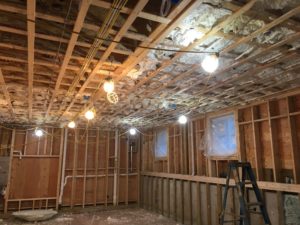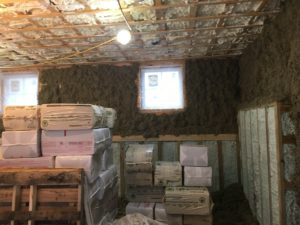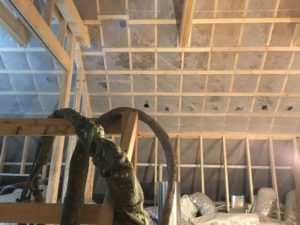A lot has happened since my last update several weeks ago. Much of September was devoted to installing the interior insulation in the project. This is one of the most important building systems in this project, and a large part of the reason we expect this house to be very efficient and airtight. We’re using a complex mix of different insulation materials, trying to match the strengths and characteristics of each material to the building environment. In earlier posts I discussed the closed-cell spray foam that insulates the basement, forming a great thermal barrier that is also structurally strong and watertight. Another post explained the exterior insulation package of rigid foam that forms a “jacket” around the house. But we’ve got a lot of other insulation types as well, and our contractor, The Green Cocoon, has done an excellent job installing them all!
The roof insulation is a mix of open-cell spray foam and dense-pack cellulose. Cellulose is a material made primarily from recycled newspapers and denim, with some additives to improve insect- and fire-resistance. It has great sound-proofing and insulating properties at a good value, and so we’ve filled the roof rafters with it. We’ve used open-cell spray foam to insulate some of the more critical junctions, like where the roof and wall intersect, and along the ridge beams so that we can get a thermal break. In the garage, where it’s important that no fumes can escape from the garage into the living space above, we’ve used a thick application of open-cell spray foam (over 12”) with a ½” foam board as a thermal break. This will keep the living spaces above the garage warm and completely air-sealed from the garage below. The open-cell foam has also been used in complicated or restricted assemblies where we want to make sure we fill the cavity with no gaps.
The above-grade walls are being filled with a different type of blown-in insulation, a spray-applied mineral wool from American Rockwool. Rockwool (mineral wool) is a non-combustible and non-corrosive material made from basalt and recycled blast furnace slag. We like it because it’s essentially fireproof (check out these amazing videos below and here), doesn’t provide food for mold, is odor free, has a higher R-value than cellulose (is a better insulator), and is a recycled material. The video above shows the technician filling wall cavities in the upstairs bathroom. After it dries, the crew “shaves” the excess material off (much of which can be re-used) to form a smooth surface for the drywall.
After insulating the exterior wall cavities and the roof, the contractor installed the interior wall insulation. Though insulation in the interior walls doesn’t influence the home’s overall energy efficiency, it does make a significant difference in interior comfort and acoustical performance (sound-proofing). We’re using Rockwool Acoustical Fire Batts. It provides good sound absorbancy and fire protection, is a recycled material, and has the advantage of being a GreenGuard Gold certified product to contribute to healthy air quality. And it has the same great fireproof properties as the blown-in mineral wool in the exterior walls.





